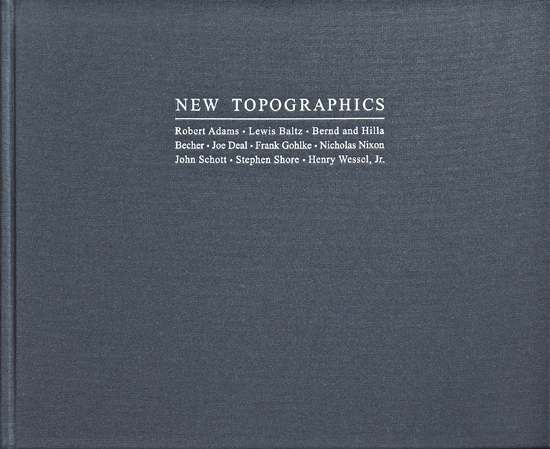| SIMON DENISON IMAGE & TEXT |
| PREVIOUS | NEXT |
NEW TOPOGRAPHICS Introduction, Britt Salvesen Steidl/Center for Creative Photography, 2009 ISBN 978-3-86521-827-8 Hb
Few shows have had such a profound and long-term impact on photography as the New Topographics exhibition of 1975. The event has acquired an almost mythical status, a kind of theogony when the great names of contemporary landscape photography, Shore, Robert Adams and the Bechers, came together as youngsters – or so the story goes – to throw down the old gods of the sublime, Ansel Adams, Weston and White, and turned landscape photography towards realism underscored by a political and social conscience. The term ‘new topographic’ is now firmly entrenched in photographic discourse as a shorthand for the style of photography that the show is meant to represent. We must live with that. But the basis for the belief is so full of holes it is leaking everywhere. Like all foundation myths there are elements of truth compromised by what has hitherto been a lack of evidence. Relatively few people saw the show at George Eastman House, appearing in reduced form at only two further venues in the United States. The modest catalogue, printed in an edition of 2,500, mostly given away to museum members and itself now long out of print, contained only 27 pictures out of the 168 which hung in the show – three for each of the nine artists who were involved (counting the Bechers as one). Much of the work remains obscure. The myth has acquired such potency because we have not been in possession of the facts. For all these reasons the republication of New Topographics is extremely welcome, indeed fascinating. Beautifully produced by Steidl, the book contains 116 of the photographs as full-page images and a complete checklist of the show as thumbnails, as well as a reproduction of the original catalogue and substantial essays by Britt Salvesen of the University of Arizona and Alison Nordström of George Eastman House. With this book we can now lay many of the myths to rest. New Topographics was not a movement. All the artists were working as individuals and some have never met even now, according to Salvesen. The show was conceived by curator Bill Jenkins and Joe Deal, one of the artists, and the works were selected to fit the show’s thesis. Henry Wessel’s work in particular was selectively represented. Frank Gohlke has distanced himself from the show’s concept and title, while Adams told Salvesen that the show was ‘a deception, but one I knew I was participating in.’ The show’s concept, as outlined by Jenkins in the catalogue, centred on neutrality of photographic style, suggesting minimal authorial input; and primacy of subject matter: what you saw in the picture was the subject, it was not a vehicle for metaphor or formal design. This seems only patchily true for the show. Deal and Nicholas Nixon made pictures that do, perhaps, suggest minimal commentary. Lewis Baltz, on the other hand, articulated a vigorous rhetoric of neutrality and yet his exquisite compositions squeal a precious concern with artistry. Adams, a romantic and neo-Platonist for whom form provides meaning and reassurance in a capricious world, could never be judged a neutral documentarist. He may have pointed his camera at the detested housing developments of Colorado but his intention was to redeem them: ‘Light,’ he wrote, ‘can transform even grotesque, inhuman things into mysteries worthy of attention.’ The association of New Topographics with political engagement is a modern misreading, based on a partial understanding of Adams’ motivations and on Baltz’s observations about the anonymity of the corporations working from the buildings in his New Industrial Parks. Nothing else in New Topographics suggests political commentary. What the work shares, at most, is its preference for the ‘straight print’ made without expressive darkroom manipulations, and its focus on the contemporary built environment. With clear precedents in the work of Evans, Atget and others, New Topographics was hardly a revolution but it does reflect a turning away by many in the 1970s from the mystical and subjective photography that was dominant in the 50s and 60s on both sides of the Atlantic. Seeing all the New Topographic work together suggests that the right people have become famous. The contributions by Shore, Adams, Baltz and the Bechers stand out. Nixon must have realised that his elevated-view cityscapes (so much less interesting than those made by John Davies in Britain the following decade) were taking him nowhere as he soon turned to portraiture, where he made his name. John Schott’s series Route 66 Motels – not a typology because there is no consistency of viewpoint – reveals some architectural curiosities, but the conflict between his craftsmanly use of a 10x8 camera and his perverse refusal to correct any of his converging verticals quickly irritates. Henry Wessel’s insipid townscapes at times recall pictures by Shore, at times by Lee Friedlander, but pale by comparison with either. Deal’s elevated views of tract landscapes in New Mexico are original and consistent, and are perhaps the truest of all the work here to the show’s thesis and topographic title, but they remain curiously dull. Gohlke’s work is the real discovery here. Although he later downplayed his contribution, saying that he ‘just kind of pulled things out of the last year’s work’ which turned out to be ‘something I went through to get someplace where I was working better’, his work is elegantly structured and full of interest and mystery. Like the best of his colleagues Gohlke describes the everyday built environment, but remembers that as an artist his first obligation is to make pictures that engage on pictorial as much as on intellectual terms. |
 |
|---|---|